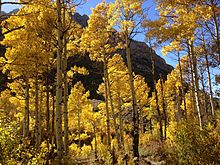
Quaking Aspen

Populus tremuloides is a deciduous tree native to cooler areas of North America, one of several species referred to by the common name aspen. It is commonly called quaking aspen, trembling aspen, American aspen, Quakies, mountain or golden aspen, trembling poplar, white poplar, popple, as well as others. The trees have tall trunks, up to 25 meters (82 feet) tall, with smooth pale bark, scarred with black. The glossy green leaves, dull beneath, become golden to yellow, rarely red, in autumn. The species often propagates through its roots to form large clonal groves originating from a shared root system. These roots are not rhizomes, as new growth develops from adventitious buds on the parent root system (the ortet). Populus tremuloides is the most widely distributed tree in North America, being found from Canada to central Mexico. It is the defining species of the aspen parkland biome in the Prairie Provinces of Canada and extreme northwest Minnesota. The Quaking Aspen is the state tree of Utah. The quaking or trembling of the leaves that is referred to in the common names is due to the flexible flattened petioles. The specific epithet, tremuloides, evokes this trembling behavior and can be literally translated as 'like (Populus) tremula', the European trembling aspen.
